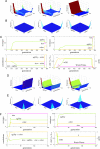Sympatric speciation under incompatibility selection
- PMID: 16864787
- PMCID: PMC1518809
- DOI: 10.1073/pnas.0602339103
Sympatric speciation under incompatibility selection
Abstract
The existing theory of sympatric speciation assumes that a local population splits into two species under one-dimensional disruptive selection, which favors both of the opposite extreme values of a quantitative trait. Here we model sympatric speciation under selection that favors high values of either of the two independently inherited traits, each required to efficiently consume one of the two available resources, but acts, because of a tradeoff, against those possessing high values of both traits. Such two-dimensional incompatibility selection is similar to that involved in allopatric speciation. Using a hypergeometric phenotypic model, we show that incompatibility selection readily leads to sympatric speciation. In contrast to disruptive selection, two distinct modes of sympatric speciation exist under incompatibility selection: under strong tradeoffs both of the new species are specialists, each consuming its own resource, but under moderate tradeoffs speciation may be asymmetric and involve the origin of a specialist and a generalist species. Also, incompatibility selection may lead to irreversible specialization: under strong tradeoffs, the population speciates if it consists mostly of unspecialized individuals, but remains undivided if most of the individuals are specialized to consume one of the resources. Incompatibility selection appears to be more realistic than disruptive selection, implying that incompatibility between individually adaptive alleles or trait states drives both allopatric and sympatric speciation.
Conflict of interest statement
Conflict of interest statement: No conflicts declared.
Figures




Similar articles
-
Sympatric speciation by sexual selection alone is unlikely.Evolution. 2004 Feb;58(2):222-37. Evolution. 2004. PMID: 15068341
-
Interactions among quantitative traits in the course of sympatric speciation.Nature. 1999 Jul 22;400(6742):351-4. doi: 10.1038/22514. Nature. 1999. PMID: 10432111
-
Ecological disruptive selection acting on quantitative loci can drive sympatric speciation.NPJ Syst Biol Appl. 2024 Jan 15;10(1):6. doi: 10.1038/s41540-024-00332-w. NPJ Syst Biol Appl. 2024. PMID: 38225420 Free PMC article.
-
Speciation through competition: a critical review.Evolution. 2005 Jun;59(6):1194-210. Evolution. 2005. PMID: 16050097 Review.
-
What, if anything, is sympatric speciation?J Evol Biol. 2008 Nov;21(6):1452-9. doi: 10.1111/j.1420-9101.2008.01611.x. Epub 2008 Sep 18. J Evol Biol. 2008. PMID: 18823452 Review.
Cited by
-
Does foraging behaviour affect female mate preferences and pair formation in captive zebra finches?PLoS One. 2010 Dec 15;5(12):e14340. doi: 10.1371/journal.pone.0014340. PLoS One. 2010. PMID: 21179514 Free PMC article.
-
The speed of ecological speciation.Funct Ecol. 2007 Jun;21(3):455-464. doi: 10.1111/j.1365-2435.2006.01240.x. Funct Ecol. 2007. PMID: 19096732 Free PMC article.
References
-
- Coyne J. A., Orr H. A. Speciation. Sunderland, MA: Sinauer; 2004.
-
- Gavrilets S. Fitness Landscapes and the Origin of Species. Princeton: Princeton Univ. Press; 2004.
-
- Maynard Smith J. Am. Nat. 1966;100:637–650.
-
- Bush G. L. Annu. Rev. Ecol. Syst. 1975;6:339–364.
-
- Kondrashov A. S., Mina M. V. Biol. J. Linn. Soc. 1986;27:201–223.
Publication types
MeSH terms
LinkOut - more resources
Full Text Sources

